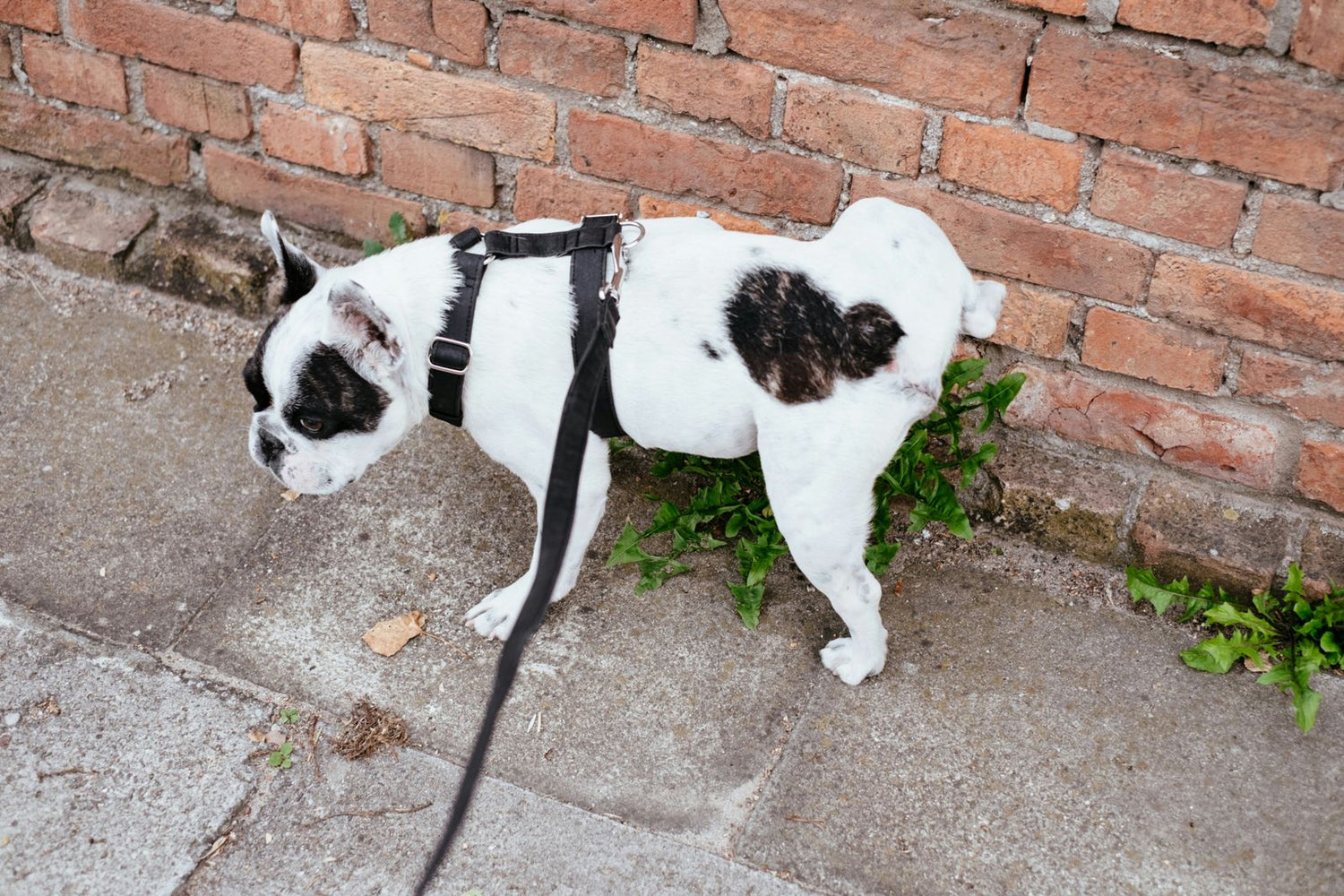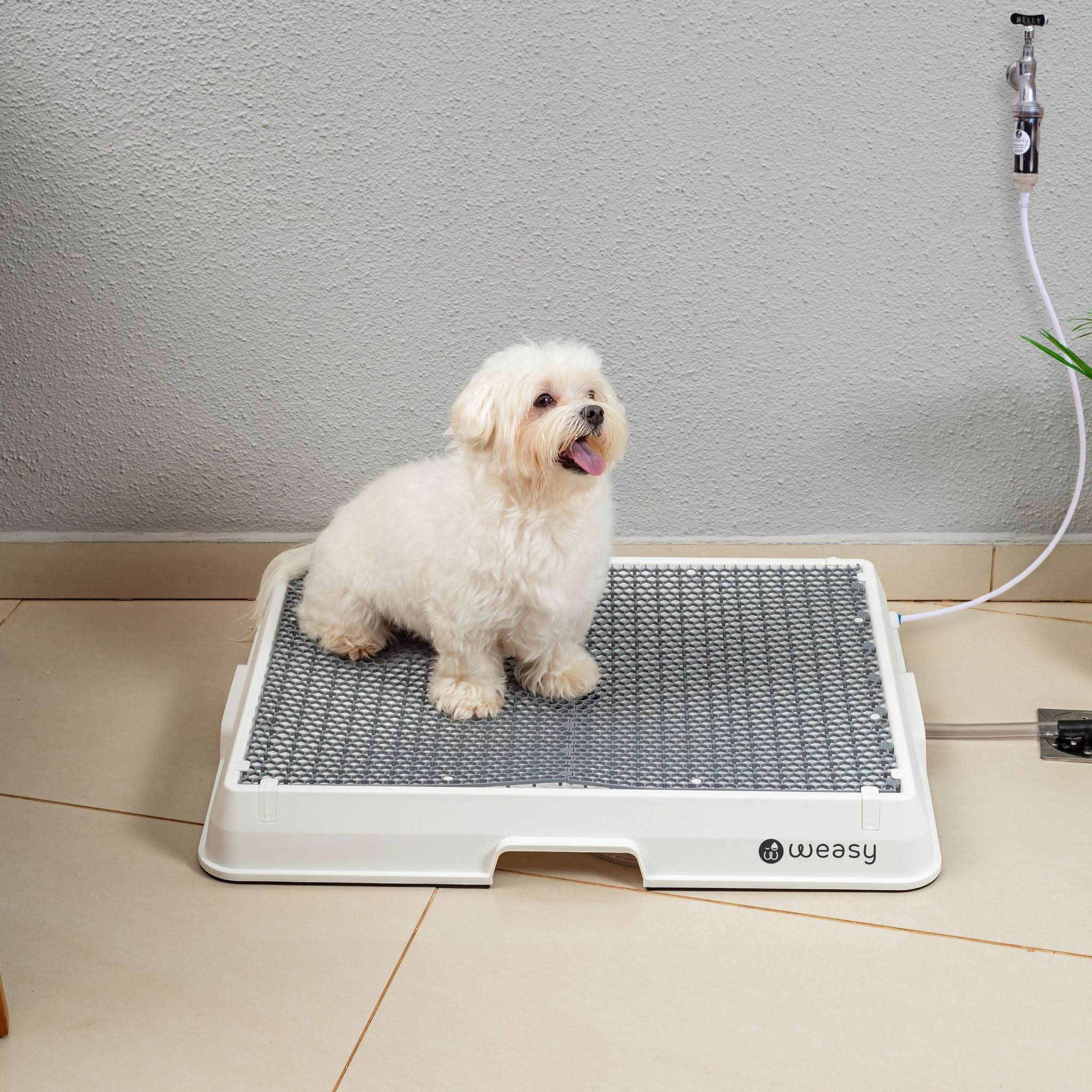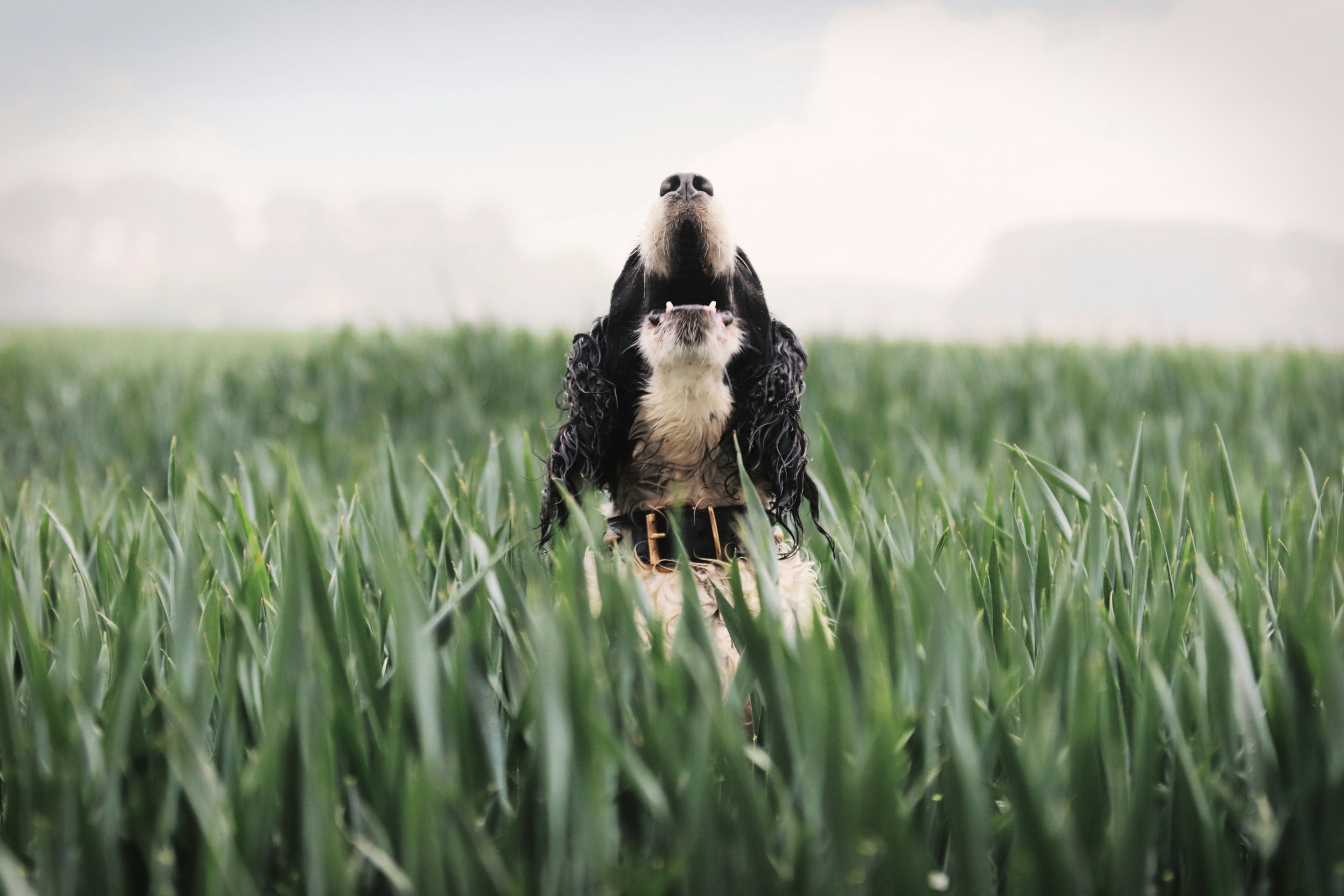Teaching your dog to pee in the right place can feel like a challenge - because frankly, sometimes it is. But with patience, know-how, and love, you can turn this process into something much lighter (and even fun - for both of you!).
In this guide, you'll find practical, expert-approved tips to help your furry friend hit the spot without turning your home into a minefield, your time at home into constant cleanup, or your bond with them into stress.
Contents
- At what age does a puppy learn to potty in the right spot?
- How long does it typically take to learn?
- How to teach your dog to pee in the right place
- My dog is peeing in the wrong spot—now what?
- Are there products that help teach dogs where to go?
- Smart dog potty: meet the Weasy
Before we begin: At what age does a puppy learn to pee in the right place?

i'm just a little baby, be patient
First days of life
Like newborn humans, puppies don’t yet have bladder control. The mother handles the “cleanup.” In this stage, your focus is on keeping them safe, keeping them warm, and ensuring mom is well fed.
Around 1 month old
Puppies start exploring a bit more—but it’s still early to expect them to pee in the proper place. Their bladder control and coordination are still developing. If they have an accident, take a deep breath—they’re just babies. You can begin by restricting their space to areas that are easier to clean. Even if you don’t use a pee pad yet, you might notice a preferred spot forming. If such a preference surfaces, gently (lovingly ant patiently) start introducing a method (more on that shortly).
2 to 3 mo
This is the sweet spot to begin formal potty training using pee pads, newspaper, grass patches —think of it like teaching a child to use a potty. Keep in mind:
- The potty area should be distant from food, water, and the bed—dogs are super clean by nature.
- The toilet spot must be easy for them to access—no tight corners or odd angles. That space under the sink might feel cozy to you, but cramped to them.
- It should feel safe—loud hallways or busy spots will make them avoid it. Potty time is when they’re vulnerable, and nobody likes an audience at their most personal moment.
4 to 6 mo
If training has been consistent, most puppies should have the whole pee spot and pee routine under control. Accidents may still happen, but the habit is forming—and you can start introducing more permanent solutions like the Weasy smart dog potty. There are three sizes available, considering small, medium and large dogs. If you have more than one dog (even if they're medium or small) or a growing pup, consider sizing up.
So, how Long Does It Take to Learn?
Short answer: It depends. Long answer? lets consider all the factors involved:
What influences potty training time?

there are lots of ways to help me learn!
-
Basic needs: Beyond food and comfort, dogs need mental, physical, and social stimulation. A well-rounded pup is more eager to learn, calmer, and less likely to make mistakes out of boredom or to seek attention—avoiding setbacks like destroyed pee pads or other destructive behavior.
-
Age: Puppies are curious and learn quickly, but often make mistakes. For them everything is new, a reason to be curious, something to learn and explore. Adult or senior dogs may have established routines, can be a little set in their ways —but they surely can learn and are interested in new things. Every dog can adapt in their own time, do not give up on your dog, no matter what age - have patience and give them a chance.
-
Routine Consistency: Dogs feel safer, more confident and have better disposition when they understand what is going on around them. Predictable schedules for meals and walks help regulate their biology, making training more effective. Chaotic routines breed anxiety, making it hard for them to understand expectations of the “pack” (meaning you, other humans and other animals that live together).
-
Positive reinforcement: Praise, treats, happy and approving talking—these show your pup they’ve done well. Both the joy of relief (pee) and the joy of pleasing combine to make them want more, and repeat the good deed. Negative reinforcement like shouting, pushing or pulling them, being intentionally cold and silent or any form of punishment do the opposite. Fear and stress slow everything down. They may stop trying, out of fear of making a mistake.
- Environment: A quiet, safe, odor-neutral area away from their food and bed is ideal. Avoid using harsh-smelling cleaners or strong scents. Leave a little bit of their own pee scent on the pad to help guide them—and keep the rest clean with mild soap or biodegradable cleaners.
How to teach your dog to pee in the right place: a guide

a great place to pee outside, but what about indoors?
- First Things First: Choose the Right Spot
A fixed, accessible place, to be the bathroom (potty)
- must be always the same
- easy fot them to get to and to move around in
- clean, no strong smells
- away from their food, toys or sleeping spot
- Now, lets introduce a metido (like a pee pad):
I. Present the Method:
Set out the pad. They might just catch on—or they might need more help.
II. Add a Natural Marker:
Use a pee pad to soak up some of their pee after an accident or walk. Place that marked pad on chosen potty spot — the familiar scent speeds learning.
III. Take Them at the Right Times:
Dogs like to go after meals. Be sure to invite them to the potty spot right after they eat. Other moments to take them there are after a nap, after playtime, when they are waking up— and especially before bedtime—when the chance of success is highest.
IV. Neutralize Wrong Spots:
Potentially, all spots that smell like pee will become potty places to your dog. SO is important to clean mistaken areas thoroughly with vinegar, baking soda, alcohol, or special store bought enzyme cleaners—without strong scents—so they don’t revisit them. Not only floors but walls and furniture.
V. Avoid Confusing Similar Surfaces:
Many objects—bathroom rugs, floor cloths, welcome mats—look like pee pads to them. If it looks like a pad, it is soft like a pad, it is on the floor like a pad - why wouldn't they think it's a pad? If they're learning, remove these confusing items.
VI. Reinforce Every Success:
Treat it like a celebration—praise, cheer, affection, treats, and fun each time they hit the right spot! Create a “success = joy” association. Not only the dog gets a joyous moment, but also us, humans. We all can benefit from a phew moments of connection and celebration a day!
VII. Skip the Scolds:
Never yell, rub their nose, or punish. Instead, ignore it (the mistake, not the dog), and clean discreetly - out of their sight - and move on. Scolding won’t create learning, but stress. And may even be understood like a way of getting your attention, if they're desperate for some (even negative attention).
VIII. Introduce Things Gradually:
One thing at a time. Stick with one change for at least five days—like changing location —before switching anything else - like method. Wait until each information “layer” it is clear and set, before adding more new information. Too much change, too fast, may confuse them about what's sticking and what's not longer necessary. Be intentional to show what’s expected of them
IX. If They Mess Up—No Problem:
Everything going well and smooth, and then a hiccup? If they start making mistakes after learning, don't worry. Just go back a step in the training, reintroduce the scent marker, clean the wrong spot, and reward each correct go. Persistence wins. Each dog, like every human, has its own pace, and we're here to help them get it. Hiccups are part of the process, it's all good!
X. Keep the Routine Going:
Just like the gym, results are compromised if you're going once, and skipping twice. Training isn’t a one-and-done deal—consistency matters as much as meals in your pup’s life. You don't skip dinner because you head breakfast, right? your body needs nourishment throughout the day. So consistency is key! And about that:
My dog is peeing in the wrong place—what do I do?

I don't mean to annoy (but, sometimes I'm asking you for attention)
Take a breath—you’re not alone. Ask yourself:
- Was the training too rushed?
- Did something change in their or your routine?
- Did you change cleaning products or smells?
- Have people or pets changed emotionally?
- Does the pup seem anxious, bored, or needy?
- Could there be a health issue?
What to do:
- If they're bored: Add structure—play time, walks, mental challenges, new experiences to explore.
- If they’re craving attention: Make time for undivided attention (putting the phone away matters). Quality over quantity.
- If it’s attention-seeking peeing: Stick to the earlier potty training steps and ignore mistakes—attention, even negative, reinforces behavior.
- If it’s just a slip-up: Reapply the steps—scent marker, clean surfaces, take them right after eating—and reward every success.
-
What it the pup is older and having accidents?
Age-related issues like incontinence, mobility, or cognitive decline can be at play. Make the potty easily accessible, keep areas well-lit, and stay close by. A little extra consideration goes a long way.
Are there products that help teach pups where to go?
Yes! Attractants mimic the smell of pee, and repellents discourage the wrong spots. But remember: it’s not magic. Consistent training is still key.
-
DIY Repellent Spray
A simple mix of white vinegar and water can help ward them off from unwanted spots—just avoid overuse and contact with their skin or delicate areas. It may be irritating for their skin to touch and breath in.
-
Special cleaning products
Store bought enzyme cleaners that eliminate odors completely help prevent repeat accidents in the same spot.
Smart potty for dogs: a more peaceful life for you and your buddy

at last!
A healthy and hidrated dog may pee every couple of hours, if they have the option. In many homes across the U.S., dogs spend hours holding it in — waiting for that next walk to finally pee or poop.
Imagine never worrying about them restraining from eating or hydrating because they can't go afterwards, or worrying about the effects on their health after holding everything in because their inside, waiting for us humans to get home from work and walk them! And imagine never again having to go out in really bad weather, waiting for them to choose a spot, while both of you freeze.
If you already use an indoor method, like a pee pad, imagine not having to deal with soaked pads, wet paws, or after-pee odors!
The Weasy smart potty is here to revolutionize your life (and your dog’s)—making both of your routines more comfortable and flexible, the cleanup easier, saving money, helping the planet, and improving their health and your bond.
What is the Weasy smart dog potty?
A smart potty made by dog lovers for dog lovers - with lots of research, technology and heart. Designed with the well-being of both dogs and humans in mind:
-
Reliable solution
Your dog can go potty when they need to. No more holding it in.
It’s freedom, comfort and health for them - flexibility and peace of mind for you.
-
Indoor potty made easy & clean
Great for apartment life, busy or unpredictable schedules, senior dogs and humans, people with limited mobility, bad weather - whenever the frequent pee/poo walks aren’t possible.
-
Eco-Friendly
Reduces waste - Weasy is made from high quality polymers that are recyclable materials. If compared to a pee pad, you will prevent at least 4 thousand pads (that's 1,278.68 lbs of waste) from going to landfills thoughout a pup's life.
-
Cost-Saving
A practical solution that doesn't need constant replacing or purchasing any disposable item. You save up at least USD$1,000.00 that would go to waste in pee pads.
How it works
The design drains urine directly into the sewer (via pipe) or a secure container (Weasy Bag), keeping the floor dry and the smell at bay. It’s built with recycled, recyclable, and durable materials—with a beautiful design.
-
Setup:
Place it at the chosen potty spot, attach the Weasy Bag underneath. Done! That easy.
-
Transition:
For the first few days, you can put your old pad right on top of the Weasy. Keep following the training steps consistently and kindly—and they'll adapt.
-
If there's a setback?
Just repeat the training steps—use markers, clean thoroughly, reward success, and be patient. Changes in routine or stimuli may cause disorientation too—watch for triggers.
That's it!
Your life needs that ease! It needs Weasy
Whether you live in a region with difficult weather (snow, heavy rain, tornados, heat strokes), an apartment, a house with no yard (or even if you want to reclaim that yard that the pup turned into a huge potty spot), if you have your hands full with both kids and pups, or if you or the pup have trouble walking outside many times a day for any reason — you can benefit from the ease and reliability of Weasy smart potty. It's so practical and hygienic! Weasy is the ally you didn't know you needed. Your pup can go comfortably even when you're away, you both stay safe and sound —and your home stays clean, dry, and fresh.
Want all the details and specs for the new Weasy model? Check out our store
Conclusion:
Teaching your dog to pee in the right place takes dedication—but it’s possible. With patience, consistency, a supportive environment—or the help of a smart potty like Weasy—you can ensure your pup’s well-being and your own peace of mind. Now go out and put these tips into action. Good luck and have fun training!





Leave a comment
This site is protected by hCaptcha and the hCaptcha Privacy Policy and Terms of Service apply.